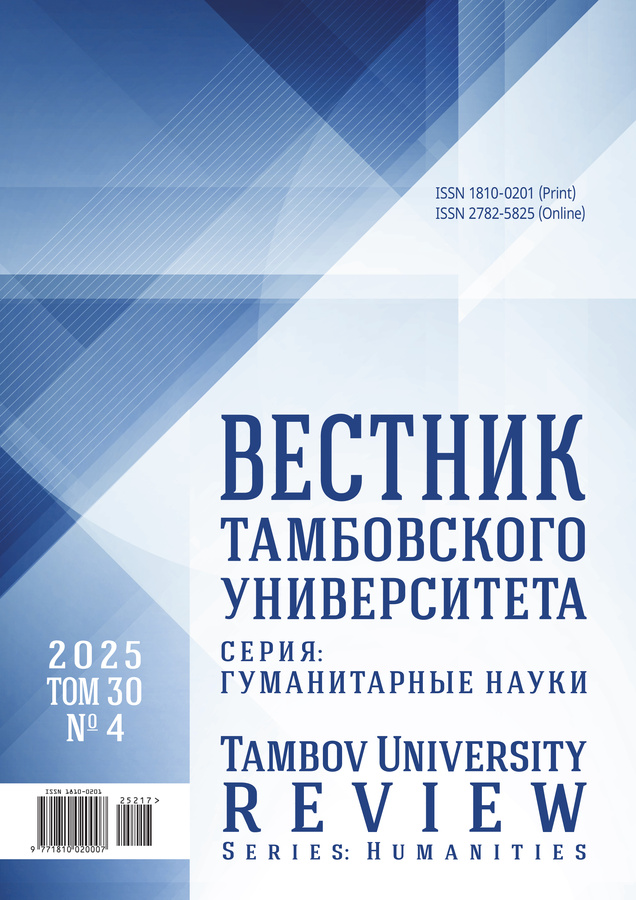Действия итальянского правительства в отношении военнопленных итальянской национальности австро-венгерской армии в годы Первой мировой войны
- Авторы: Шевяков С.В.1
-
Учреждения:
- ФГБОУ ВО «Тамбовский государственный университет им. Г.Р. Державина»
- Выпуск: Том 29, № 3 (2024)
- Страницы: 857-868
- Раздел: ИСТОРИЯ ЗАРУБЕЖНЫХ СТРАН
- URL: https://bakhtiniada.ru/1810-0201/article/view/297847
- DOI: https://doi.org/10.20310/1810-0201-2024-29-3-857-868
- ID: 297847
Цитировать
Полный текст
Аннотация
Актуальность. С 1915 по 1917 г. в г. Кирсанов Тамбовской губернии функционировал лагерь для австро-венгерских военнопленных итальянской национальности, которые приняли предложение Итальянского правительства об отправке в Италию и последующем вступлении их в ряды ее вооруженных сил. Итальянское правительство решило тщательно отбирать военнопленных на основе их политико-национальной благонадежности, тем самым задерживало репатриацию. Военнопленные стали писать в ирредентистские ассоциации в Италии и национальную прессу, тем самым оказывая давление на правительство Италии. В результате этих действий правительство Италии изменило курс на скорейшую отправку военнопленных. Деятельность военнопленных недостаточно освещена в современной историографии. Цель исследования – воздействие средств массовой информации на правительство Италии, которое оказывали военнопленные австро-венгерской армии итальянской национальности в Тамбовской губернии в годы Первой мировой войны, направленных на ускорение репатриации в Итальянское королевство.Материалы и методы. Источниковой базой послужили архивные материалы, а также ряд опубликованных исследований. Был использован ретроспективный метод, который позволил воссоздать по отдельным деталям и более поздним источникам действия итальянского правительства по отношению к австро-венгерским военнопленным итальянской национальности.Результаты исследования. Показано, что отправка военнопленных в Италию задерживалась по инициативе итальянского правительства. Военнопленные, находившиеся в кирсановском лагере, смогли при помощи средств массовой информации произвести давление на итальянское правительство. Весной 1916 г. правительство, поняв возможные негативные последствия, дало согласие в пользу всех военнопленных, согласившихся вступить в вооруженные силы Италии, а не ограничено несколькими офицерами, способными оплатить поездку. Выводы. В период ожидания отправки в Италию группа военнопленных солдат и офицеров обращалась в национальную прессу и ирредентистские ассоциации. Целью этих обращений было давление на итальянское правительство, которое должно было ускорить репатриацию военнопленных.
Ключевые слова
Об авторах
С. В. Шевяков
ФГБОУ ВО «Тамбовский государственный университет им. Г.Р. Державина»
Автор, ответственный за переписку.
Email: mig1709@mail.ru
ORCID iD: 0000-0001-8699-7240
научный сотрудник лаборатории социальной истории
392000, Российская Федерация, г. Тамбов, ул. Интернациональная, 33Список литературы
- Интернационалисты: участие трудящихся стран Центральной и Юго-Восточной Европы в борьбе за власть Советов в России 1917–1920 гг. / отв. ред. А.Я. Манусевич. М.: Наука, 1987. 450 с.
- Нахтигаль Р. Военнопленные в России в эпоху Первой мировой войны // Quaestio Rossica. 2014. № 1. С. 142-156. https://elibrary.ru/seyxmx
- Lyons M. The Writing Culture of Ordinary People in Europe, c. 1860–1920. Cambridge: Cambridge University Press, 2012. 278 p. https://doi.org/10.1017/CBO9781139093538
- Шевяков С.В. «Кирсановское движение» военнопленных итальянской национальности австровенгерской армии в годы Первой мировой войны // Вестник Тамбовского университета. Серия: Гуманитарные науки. 2023. Т. 28. № 3. С. 725-736. https://doi.org/10.20310/1810-0201-2023-28-3-725-736, https://elibrary.ru/qtuahi
- Bellezza S.A. Tornare in Italia: Come i Prigionieri Trentini in Russia Divennero Italiani (1914–1920). Bologna: Società editrice Il Mulino, 2016. 240 p. https://doi.org/10.978.8815/328960
- Ди Микеле А. Меж двух мундиров. Италоязычные подданные Австро-Венгерской империи на Первой мировой войне и в русском плену / пер. и науч. ред. М.Г. Талалая. СПб.: Алетейя, 2022. 286 с. https://elibrary.ru/qfrrkx
- Nachtigal R. Privilegiensystem und Zwangsrekrutierung. Russische Nationalitätenpolitik gegenüber Kriegsgefangenen aus Österreich-Ungarn // Kriegsgefangene im Europa des Ersten Weltkriegs / hrsg. von J. Oltmer. Paderborn: Schöningh, 2006. S. 167-193.
- Митрофанов П.П. История Австрии. СПб.: Брокгауз–Ефрон, 1910. Ч. 1. С древнейших времен до 1792 г. 158 с.
- Baurmann J., Günther H., Knoop U. Homo scribens: Perspektiven der Schriftlichkeitsforschung. Berlin; New York: Max Niemeyer Verlag, 1993. 394 S. https://doi.org/10.1515/9783111377087
- Bazzani G. Soldati Italiani nella Russia in Flamme 1915–1920. Trento: Legione trentina, 1920. 429 p.
- Di Michele A. Patrioti irredenti o fedeli servitori dell’imperatore? Immagini e realtà dei soldati di lingua italiana nell’Esercito austro-ungarico durante la Grande Guerra // Il 1918. La Vittoria e il Sacrificio: Congresso di Studi Storici Internazionali. Roma, 2019. Р. 315-338.
- Salvador A. Italian-Speaking Austrian POWs in Russia and the Italian Involvement in the Siberian Intervention 1918–1920 // Re-visiting World War I: Interpretations and Perspectives of the Great Conflict / eds. J. Suchoples, S. James. Bern: Peter Lang Edition, 2016. P. 207-223. https://doi.org/10.53351/ruhm.v7i15.500
- Salvador A. Considerazioni sul rimpatrio e la smobilitazione dei soldati austro-ungarici di nazionalità italiana nel primo dopoguerra // Qualestoria. Rivista di Storia Contemporanea. 2014. Vol. 42. № 1-2. P. 59-75.
- Simonetti I. Dal diario di un trentino prigioniero di guerra in Siberia:// Bollettino Del Museo Trentino Del Risorgimento. 1984. Vol. 33. № 3. P. 21-28.
- Rachamimov А. POWs and the Great War: Captivity on the Eastern Front. Oxford: Berg, 2002. 259 p.
- Guarasci R. Cosma Manera e la Legione Redenta: La Storia e l’archivio. Canterano: Aracne, 2018. 148 p.
- Biagini A. In Russia tra Guerra e Rivoluzione: La Missione Militare Italiana, 1915–1918. Roma, 1983. 203 p.
Дополнительные файлы









